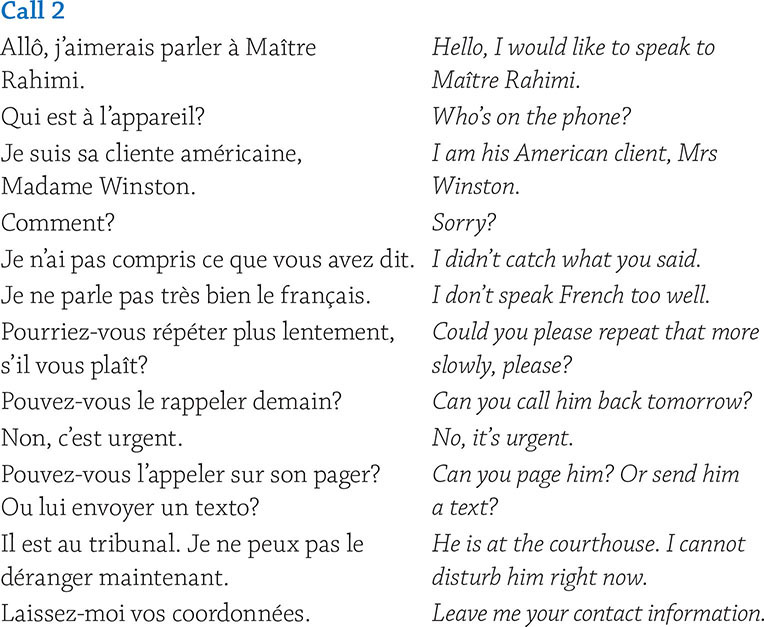10 Discussing the Future and Making Plans
We can never know for sure what the future will hold. But heureusement, the future tense in French, is quite predictable. Still, you’ll have to memorize the stems for irregular verbs, and, as the French often say: Vouloir c’est pouvoir. While this expression literally translates to “Willing is to be able to,” it carries nearly the same meaning as the expression Where there’s a will, there’s a way. Keep this expression in mind as you learn in this chapter about verbs such as vouloir, pouvoir, and devoir.
The Simple Future
French has two main future tenses: the futur simple and the futur antérieur. For most verbs, to form the futur simple, use the infinitive as the stem and add the appropriate endings (-ai, -as, -a, -ons, -ez, or -ont). For -re verbs, remember to first drop the e from the infinitive and then add the appropriate ending.
Here are a few examples:
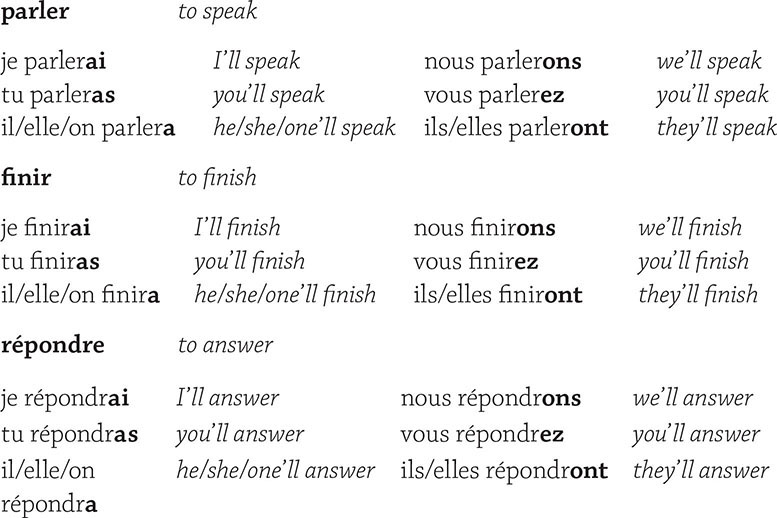

Irregular Future Verbs
The endings of the futur simple are the same for all verbs, yet many verbs have irregular stems. You’ll have to pay extra attention to these!


And with some verbs, the spelling changes when conjugated in the future tense.


Temporal Conjunctions
Similar to English, the future tense is used to describe upcoming events, like Elle ira à Paris en mai (She’ll go in May). In a compound sentence, if the main clause is in the future, the dependent clause introduced by a conjunction will also be in the future. This is a stark contrast with English, where the dependent clause is put in the present tense.


The Future Perfect Tense
The futur antérieur (future perfect) describes an action that will take place and be completed before another future action. To form the compound tense, use the future tense of avoir or être and the past participle of the main verb. Agreement rules are the same as for the passé composé. Although it is rarely used in English, it must be used in French under certain circumstances.


The Verbs Vouloir, Pouvoir, and Devoir
Vouloir, pouvoir, and devoir are three of the most useful verbs with the suffix -oir.
Vouloir
The verb vouloir means to want, allowing you to express wishes and desires. Let’s take a look at how it is conjugated in the present tense.


Pouvoir
The verb pouvoir means can or to be able to.


In a formal context, when using pouvoir to ask permission with inversion, the first-person singular of pouvoir takes a different form.

Another formal way to ask a question is to use the conditional form.

Devoir
The verb devoir (must, to have to, to be supposed to, to owe) is an irregular verb with several meanings.

Let’s start with the notion of debt in both a literal and figurative sense.
■ Devoir as debt

■ Devoir as obligation

■ Devoir as probability

■ Devoir as warning or suggestion When using in the conditional or the past conditional, devoir takes on the meaning of should or should have. Again, this will be explored further in Chapter 12.

Main Prepositions
Prepositions connect two elements in a sentence. Note than when using some prepositions like à and de, there are contractions with certain articles:
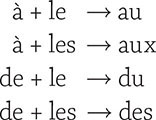



En versus dans
While both en and dans often mean similar things, each is used differently. En is used directly before a noun, whereas dans can be followed by an article, possessive adjective, or demonstrative adjective. Additionally, en carries a more general sense, while dans is more specific.

Speaking About Directions
You’ll want to learn the points of the compass:



Asking for and Giving Directions
Help! Où se trouve la gare? In order to find a destination, knowing how to ask for and follow directions really comes in handy. Here are some helpful expressions:

Mathieu, who works at La Défense, takes the afternoon off to see an exhibit at the musée Yves Saint-Laurent, 5 avenue Marceau. When he is about to leave the museum, he suddenly runs into an American tourist looking for the Eiffel Tower. Let’s look at a plan de Paris and follow the directions:
Vous sortez du musée et vous tournez à droite.
↓
Vous suivez l’avenue Marceau jusqu’à l’avenue de Président Wilson.
↓
Vous tournez à gauche et vous vous dirigez vers le pont de l’Alma.
↓
Vous traversez le pont de l’Alma et ensuite vous tournez à droite sur le quai Branly.
↓
Vous allez tout droit et vous trouverez la tour Eiffel et le célèbre Champ-de-Mars.
Phone Etiquette
The following lines represent different situations that might arise during a phone call; it will help you get an idea of the flow of French exchanges over the phone.
 DIALOGUE Service des objets trouvés Lost and Found Department
DIALOGUE Service des objets trouvés Lost and Found Department
Mathieu lives in Nogent-sur-Marne and works at La Défense. The RER A from Grande-Arche-La-Défense makes seven stops and takes about 23 minutes to reach Mathieu’s home. Célia is reading a graphic novel based on La délicatesse written by best-selling author, David Foenkinos.

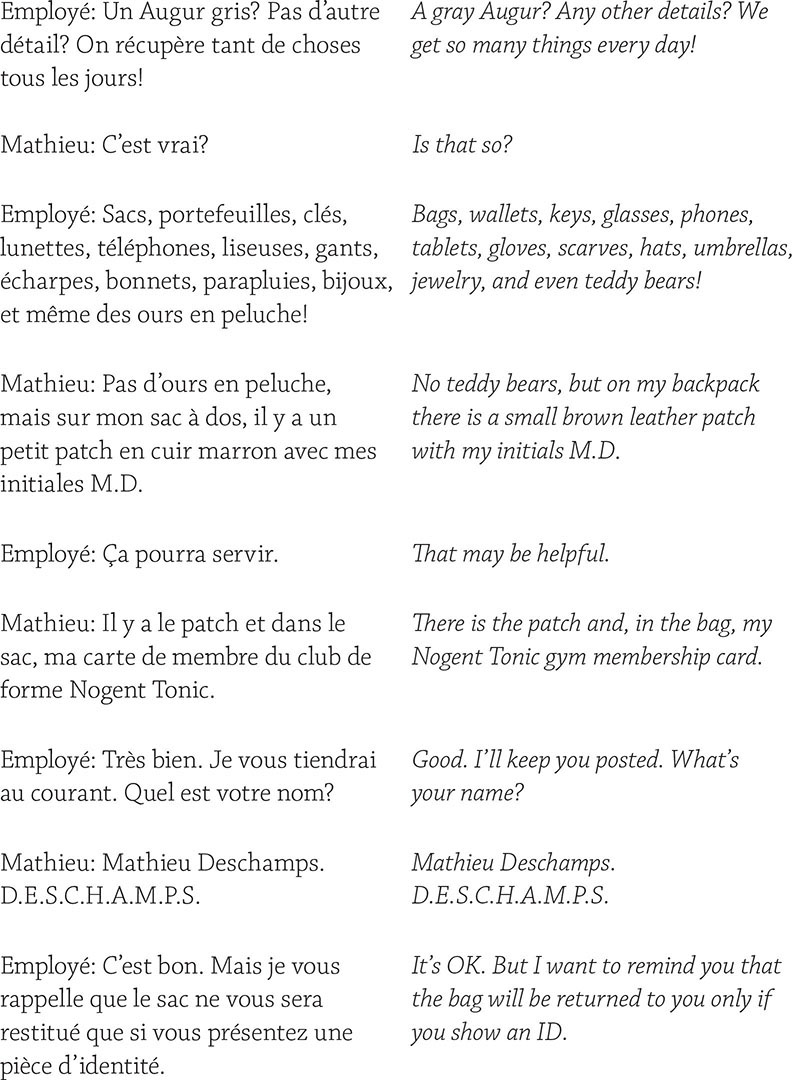


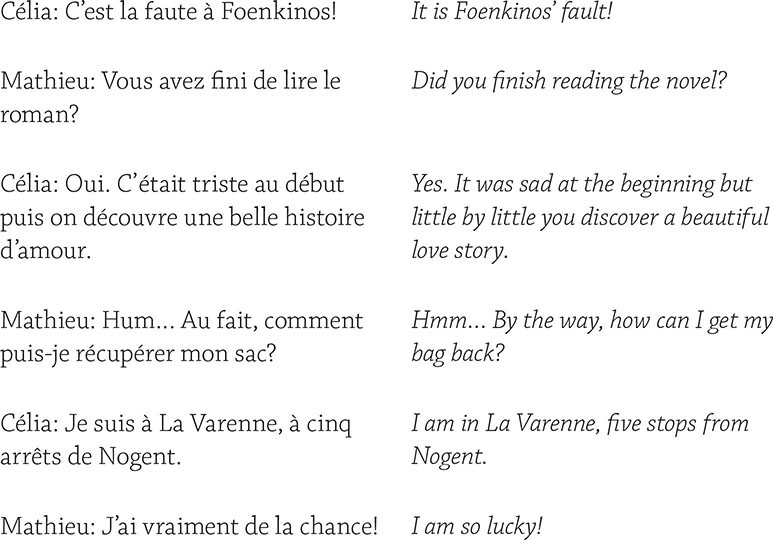

EXERCISES
EXERCISE 10.1
Conjugate the following verbs in the future.
1. Je (suivre) _______________ un cours d’espagnol l’été prochain.
2. Nous (chercher) _______________ un appartement dans le 20e arrondissement.
3. Ils (écouter) _______________ un concert à l’Olympia.
4. Tu (rester) _______________ en France toute l’année?
5. J’espère que Mathieu (ne pas perdre) _______________ son sac à dos dans le métro.
6. Elle (choisir) _______________ un beau cadeau pour sa camarade de classe.
7. Est-ce que vous (sortir) _______________ demain soir avec nous?
8. On (dîner) _______________ tous ensemble samedi.
9. Je (ne pas travailler) _______________ le 14 juillet.
10. On (remplacer) _______________ toutes les chaises de bureau avant la fin de l’année.
EXERCISE 10.2
Conjugate the following verbs in the future.
1. Je pense qu’il (pleuvoir) _______________ ce soir.
2. Je (venir) _______________ te chercher à la sortie du RER.
3. Nicole (s’apercevoir) _______________ qu’elle a perdu ses lunettes.
4. Nous (aller) _______________ à Nogent-sur-Marne ce weekend.
5. Est-ce que tu (être) _______________ disponible demain après-midi?
6. Les cours (avoir) _______________ lieu dans l’amphithéâtre.
7. (faire) _______________ -vous un stage chez Saint-Gobain?
8. Jean (recevoir) _______________ son diplôme en juin.
9. Combien de temps est-ce qu’il te (falloir) _______________ pour terminer le projet?
10. Dans cinquante ans, cet investissement (ne rien valoir) _______________.
EXERCISE 10.3
Conjugate the following verbs in the future tense.
1 Je vous (prévenir) _______ dès que je (savoir) _______ la date du pique-nique.
2. Tu me (envoyer) _______ un mail dès que tu (pouvoir) _______.
3. Nous (prendre) _______ une décision lorsque nous (avoir) _______ plus d’information.
4. Dès qu’Annabelle (revenir) _______ chez elle, elle (commencer) _______ ses devoirs.
5. Tant qu’il (faire) _______ beau, nous (dîner) _______ dans le jardin.
6. Aussitôt que je (arriver) _______ à Roissy, je vous (téléphoner) _______.
7. Je (acheter) _______ une nouvelle robe quand il (se marier) _______.
8. Il (devoir) _______payer ses impôts quand il (travailler) _______.
9. Qu’est-ce que tu (faire) _______ quand tu (être) _______ grand?
10. Tant qu’elles (être) _______ performantes, elles (jouer) _______ dans cette équipe.
EXERCISE 10.4
Conjugate the following verbs in the future perfect.
1. D’ici la fin de la semaine je (apprendre) _______________ le poème par cœur.
2. Christian (déménager) _______________ à La Rochelle avant la fin de l’année.
3. Quand tu (apprendre) _______________ à nager, tu pourras aller à la plage.
4. Dès que les candidats (présenter) _______________ leur programme, nous en discuterons ensemble.
5. D’ici la rentrée, nous (visiter) _______________ cinq pays africains.
6. Aussitôt que vous (lire) _______________ ce recueil de nouvelles, vous m’en ferez un résumé.
7. Quand tu (essuyer) _______________ la vaisselle, tu la rangeras dans le placard.
8. Dès que le printemps (arriver) _______________, nous irons cueillir des fleurs sauvages.
9. Dès que Lise (changer) _______________ le pneu, nous reprendrons la route.
10. D’ici la fin du semestre, les élèves (écrire) _______________ quatre essais.
EXERCISE 10.5
Translate the following sentences. When asking a question, use the est-ce que form.
1. She’ll call you as soon as she’s ready. (vous)
2. I hope it won’t rain tomorrow.
3. By the end of the week, they’ll have resolved the problem.
4. As long as there are men, there will be wars.
5. By the end of the month, the director will have signed Xavier’s contract.
6. Will you remember your sister’s birthday? (tu)
7. I am sure you won’t die of hunger in France. (tu)
8. As soon as I am finished preparing dinner, I’ll set the table.
9. We will never know who took Mathieu’s backpack.
10. As long as we love each other, we’ll be happy. (on)
EXERCISE 10.6
Conjugate the following verbs in the present tense.
1. Est-ce que tu (pouvoir) _______________ m’apporter une bouteille d’eau?
2. Je (ne pas pouvoir) _______________ lui rendre visite aujourd’hui.
3. Nous (vouloir) _______________ les inviter à la fête.
4. Tu (vouloir) _______________ nous rejoindre au jardin zoologique?
5. Elles (pouvoir) _______________ y aller en voiture.
6. Je (ne pas vouloir) _______________ vous déranger.
7. Il (vouloir) _______________ vérifier que l’objet n’est pas chez lui.
8. Vous (pouvoir) _______________ prendre contact avec le service en composant le 3246.
9. Nous (vouloir) _______________ récupérer les clés de l’appartement.
10. (pouvoir) _______________-je vous aider à porter les bagages?
EXERCISE 10.7
Conjugate the verb devoir in the present tense.
1. Tu (devoir) _______________ laisser ton sac à dos au vestiaire.
2. Vous lui (devoir) _______________ 1000 €.
3. Je (devoir) _______________ fermer toutes les fenêtres avant de partir.
4. L’avion (devoir) _______________ atterrir à 16h20.
5. On (ne pas devoir) _______________ parler trop fort au téléphone dans les transports publics.
6. Ils (devoir) _______________ tenir leur promesse.
7. Nous (devoir) _______________ passer nos vacances avec nos amis au Portugal.
8. Vous (devoir) _______________ signaler un objet perdu sur les réseaux sociaux.
9. Je (devoir) ________ arriver à Bordeaux vers 19h00.
10. Elle (ne pas devoir) _______________ sa réussite qu’à elle-même.
EXERCISE 10.8
Translate the following sentences using the vous form when necessary. When asking a question, use inversion.
1. I can’t remember the password.
2. We want to spend our vacation in Mexico.
3. She owes us an apology.
4. Can you drop me off at the movie theater?
5. They want to take time to reflect.
6. You must always tell the truth.
7. It’s supposed to rain this weekend.
8. Can I help you choose a dress for the wedding?
9. Are we supposed to learn these verbs by heart?
10. They want to meet the new history teacher.
EXERCISE 10.9
Match the items in the two columns. Choose the most logical answer.
EXERCISE 10.10
Translate the following sentences using the vous form when necessary. When asking a question, use inversion.
1. I’ll call you in three days.
2. He placed his backpack under the seat.
3. Do you want to sit next to us?
4. Do you have to go to the bank today?
5. Between us, I think that Julien likes my cousin Claire a lot.
6. Can I park my car in front of your house?
7. We’ll go to welcome them upon their arrival to Havana.
8. She is able to write a speech in less than 24 hours.
9. You are with us or against us.
10. He probably left without them.

LE COIN DES CRÉATEURS
L’expansion is a fun activity where you can fluff up an idea and a sentence. Take the example:
Le président est assis.
Le président est assis bien droit.
Le président est assis bien droit derrière son bureau.
Le président est assis bien droit derrière son bureau en chêne massif.
Le président est assis bien droit derrière son bureau en chêne massif. Il décroche le téléphone.
…
…
…
Write at least six more sentences, using the future, starting the sentence with:
La princesse ira en Islande…
…
…
NOTE CULTURELLE
TAKE A CHANCE, TAKE THE TRAIN!
Take the train, not the plane. Many people in France are now opting to do just that. The digital version of the daily newspaper Le Figaro recently conducted a poll asking users to indicate their preference and received more than 40,000 responses. The surprising result: 59 percent of those responding prefer to take trains rather than planes, even if it means abandoning their dreams of long-distance travel in favor of locations closer to home. Even more surprising is their reason: to preserve the environment and lower individual carbon dioxide (CO2) emissions. According to the European Environment Agency, a passenger in a plane emits 285 grams of CO2 per kilometer, versus 158 grams in a car and only 14 grams in a train. It is obvious that opting for the train can have a significant impact on the environment if enough people do so.
Although saving the planet is an admirable objective, it is just one reason to take the train. Travel by train is quick, easy, and economical. The opportunity to jump-start your vacation by seeing some beautiful scenery en route to your destination is an extra advantage you typically do not have in a plane at 35,000 feet. If you are traveling from Paris, you can go almost anywhere in Europe by train. And, if you don’t want to go too far, there are many day trips that you can take, leave early in the morning and be back in Paris by evening. So why not take a chance and take the train?
There are seven major train stations in Paris for trains that go beyond the Ile de France region. Before taking the train, stop and admire their architecture and décor. In some cases, it is worth a trip to the station even if you not traveling!
The Gare du Nord, officially Paris-Nord, is the busiest railway station in Europe and the hub for Eurostar trains arriving and departing Paris. Eurostar is an international high-speed railway service connecting London with Paris, Amsterdam, Avignon, Brussels, Bourg-Saint-Maurice, Disneyland Paris, Lille, Fréthun, Lyon, Marseille, and Rotterdam. Gare du Nord is also the stop for Thalys trains. Thalys is a French-Belgian high-speed train operator originally built around the LGV Nord high-speed line between Paris and Brussels. This track is shared with Eurostar trains and with French domestic TGV trains. Along with the local and national train lines, this station is always a bustling beehive of activity with trains running to Northern France and the northern suburbs of Paris.
The Gare de l’Est, officially Paris-Est, is located a short ten-minute walk from Gare du Nord (you can also take the bus or metro—it connects to the Magenta metro stop). It is the terminus of an important railway network extending towards the eastern part of France, and in the past, it saw large mobilizations of French troops, most notably in 1914, at the beginning of the First World War. In the main-line train hall, a monumental painting by Albert Herter, Le Départ des poilus, August 1914, dating from 1926, illustrates the departure of these soldiers for the Western Front. The SNCF began LGV East European services from the Gare de l’Est in June 2007, with TGV and ICE services to northeastern France, Luxembourg, southern Germany, and Switzerland. Trains to the eastern suburbs of Paris also depart from this station.
The Gare d’Austerlitz, officially Paris-Austerlitz, is located on the left bank of the Seine in the southeastern part of the city. It is the starting point of the Paris–Bordeaux railway, and the line to Toulouse is also connected to this line. Some 30 million passengers use the station annually, about half the number passing through Montparnasse. Trains from the Gare d’Austerlitz go to central France, Toulouse, and the Pyrenees. It is also the station for Elipsos high-speed trains to and from Barcelona.
The Gare de Bercy is a modern station that occupies the site of a large former freight station, once famous as the main arrival point and distribution center for wine in Paris. The renovated station was designed for sleeper trains, allowing passengers to travel with their car in the same train. This is not possible at any of the other Parisian terminal stations, as they have never been adapted for auto-train service. Between 2002 and 2011, it was the terminus for overnight trains to Italy. These now depart from the Gare de Lyon. The station has been renamed the Paris Gare de Bercy Bourgogne Pays d’Auvergne Train Station and is used primarily as a terminus for medium-distance domestic train service.
The Gare de Lyon, officially Paris-Gare-de-Lyon, is the third busiest train station in France and one of the busiest in Europe, handling about 90,000,000 passengers every year. It was built for the World Exposition of 1900 and is considered a classic example of the architecture of its time. Of particular note is the large clock tower atop one corner of the station, similar in style to London’s Big Ben. The station houses the Le Train Bleu restaurant, which has served drinks and meals to travelers and other guests since 1901 in an ornately decorated setting that is a destination on its own. The Gare de Lyon is the northern terminus of the Paris-Marseille railway. It is named after the city of Lyon, a stop for many long-distance trains departing here, most en route to the south of France. It is served by high-speed TGV trains to south and eastern France, Switzerland, Germany, Italy, and Spain. The station also hosts regional trains, the RER, and the Gare de Lyon metro station.
The Gare Montparnasse, officially Paris-Montparnasse, is located in the 14th and 15th arrondissements of Paris. The station opened in 1840, was rebuilt in 1852, and was relocated in 1969 to a new station just south of the original location—where subsequently the Montparnasse Tower, the tallest skyscraper in France until 2011, was constructed. The station serves intercity TGV trains to the west and southwest of France, including Tours, Bordeaux, Rennes, and Nantes, and suburban and regional services on the Transilien Paris–Montparnasse routes. There is also a major metro stop at the station. It is worth noting that the Gare Montparnasse is the only mainline terminus in Paris that is not directly connected to the RER system.
The Gare Saint-Lazare, officially Paris-Saint-Lazare, is the station serving Normandy, northwest of Paris, along the Paris–Le Havre railway. It is the second-busiest station in Paris, after the Gare du Nord, but most of today’s buildings, including the façade, date from 1889. The station was renovated in 1936 and again in 2012, when the three-level shopping mall was created. The Gare Saint-Lazare has been represented in a number of artworks. It attracted artists during the Impressionist period, and many of them lived very close to the Gare Saint-Lazare during the 1870s and 1880s. The station is the subject of paintings by Édouard Manet, Gustave Caillebotte, and Claude Monet, and also plays a role in literary works by Émile Zola (La bête humaine) and Raymond Queneau (Exercises in Style).

Claude Monet: La Gare Saint-Lazare, le train de Normandie (Arrival of the Normandy Train, Gare Saint-Lazare), 1877. Collection of the Art Institute of Chicago.
 KNOW
KNOW The French are keen on balancing tenses—especially when it comes to the future.
The French are keen on balancing tenses—especially when it comes to the future.







